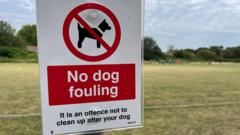Why Are Wild Pigs in California Turning Neon Blue?

Understanding the Phenomenon of Blue Wild Pigs in California
Recently, a peculiar phenomenon has emerged in California's wild pig population, with reports of feral hogs exhibiting an unusual neon blue coloration reminiscent of Cool Blue Gatorade. This striking hue has sparked curiosity and concern among hunters and wildlife enthusiasts alike. With approximately 400,000 feral hogs residing in California, the discovery of these blue pigs raises questions about the health implications for wildlife and humans. This article explores the causes of this bizarre pigmentation, its implications, and what it means for hunters and the broader ecosystem.
The Discovery of Blue Hogs
The first reports of blue-hued wild pigs came from Dan Burton, a wildlife control expert, who discovered a discolored pig in Monterey County earlier this year. Upon inspecting the animal, Burton was shocked to find that its internal tissues were not just slightly blue but a vivid, slushie-like shade. He stated, “I’m not talking about a little blue; I’m talking about neon blue, raspberry blue.” This alarming discovery prompted further investigations into the cause of the pigmentation.
Historical Context of Blue Pigs
The phenomenon of blue wild pigs is not entirely new. In 2015, a similar case was shared on Imgur, where a user recounted their experience with a blue pig shot on their in-laws' ranch in Morgan Hill, Santa Clara County. They noted that while the pig's external appearance resembled that of a typical swine, the internal fat had a strange blue tint. This historical context suggests that the occurrence may have been sporadic rather than an isolated incident.
The Role of Diphacinone in the Blue Pig Phenomenon
Upon further investigation, wildlife officials discovered that the blue pigmentation in the pigs was linked to the ingestion of diphacinone, a slow-acting rodenticide. Farmers often use this chemical to control populations of rodents, such as squirrels and rats. Diphacinone works by inhibiting blood clotting, which can result in severe internal bleeding, fever, and pain in affected animals.
The Chemical Mechanism
Diphacinone is dyed blue to distinguish it as a rodenticide, making it clear to humans that the substance is toxic. However, this dye has unintended consequences when ingested by animals, including wild pigs. When pigs consume a significant amount of the poisoned bait or the affected rodents, the dye leaks into their muscles and fat, resulting in the striking blue coloration of the meat. This occurrence has raised alarms about the safety of consuming such meat, as the poison can remain in the animal's system for weeks.
The Implications for Wildlife and Humans
The discovery of blue pigs has serious implications for both wildlife management and human health. Wildlife officials have expressed concerns about the potential for secondary exposure to the toxin. Predators that consume the blue meat may also face health risks due to the lingering presence of diphacinone in the pig’s system. Additionally, cooking the discolored meat does not significantly reduce the concentration of the poison, making it unsafe for human consumption.
Health Risks of Diphacinone Exposure
According to government fact sheets, exposure to diphacinone can lead to several severe health issues, including:
- Heavy internal bleeding
- Fever
- Back pain
These risks extend not only to the pigs but also to any humans or animals that may consume the affected meat. Consequently, wildlife officials are urging hunters and trappers to avoid blue-colored meat and to report any sightings of blue pigs to the appropriate authorities.
Monitoring and Regulation of Diphacinone Use
In response to the emerging concerns about rodenticide exposure in wildlife, California has enacted regulations regarding the use of diphacinone. Since 2024, this chemical has been largely prohibited for general use, restricted to certified pest control specialists and government agencies. This regulation is aimed at reducing the risk of secondary poisoning in non-target wildlife, including the diverse range of animals that inhabit California's ecosystems.
Wildlife Conservation Efforts
The California Department of Fish and Wildlife (CDFW) is actively monitoring the situation and conducting investigations into wildlife contaminated with rodenticides. Dr. Ryan Bourbour, a pesticide investigations coordinator, noted that nearly one in ten wild pigs in human-controlled areas showed signs of contamination. This statistic highlights the pressing need for ongoing research and conservation efforts to protect wildlife from the adverse effects of chemical exposure.
How to Stay Safe: Guidelines for Hunters
For hunters and outdoor enthusiasts, safety is paramount. Here are some guidelines to follow if you encounter blue wild pigs:
- Avoid Consumption: Do not consume any meat that appears blue or discolored.
- Report Sightings: Notify the CDFW about any blue pigs you encounter to assist in monitoring and management efforts.
- Educate Yourself: Stay informed about the risks associated with rodenticides and their impact on wildlife.
- Practice Ethical Hunting: Adhere to hunting regulations and ethical practices to minimize harm to wildlife populations.
Future Research Directions
The phenomenon of blue wild pigs opens up several avenues for future research. Scientists may explore the long-term effects of rodenticide exposure on pig populations and their predators. Additionally, studies can investigate the ecological impact of rodenticides on the broader food web, particularly in regions where wildlife and agriculture intersect.
Encouraging Sustainable Practices
To mitigate the risks associated with rodenticides, it is crucial for farmers and pest control professionals to adopt sustainable practices. Alternatives to chemical rodenticides, such as habitat modifications and biological control methods, can help manage rodent populations without endangering non-target wildlife.
Conclusion
The emergence of blue wild pigs in California serves as a stark reminder of the complex interactions between wildlife, agriculture, and the chemicals we use to control pest populations. As researchers and wildlife officials work to understand and address this phenomenon, it is essential for hunters and the public to remain informed about the risks and to engage in responsible practices. By fostering a deeper understanding of these issues, we can contribute to the health of wildlife and the safety of our food systems.
FAQs About Blue Wild Pigs
What causes wild pigs to turn blue?
The blue coloration in wild pigs is primarily caused by the ingestion of diphacinone, a rodenticide used to control pest populations. The blue dye in the poison can leak into the pig's muscles and fat, resulting in the bizarre hue.
Is it safe to eat blue wild pig meat?
No, it is not safe to eat blue wild pig meat. The presence of diphacinone poses serious health risks, and cooking the meat does not significantly reduce the concentration of the poison.
What should I do if I see a blue wild pig?
If you encounter a blue wild pig, you should report the sighting to the California Department of Fish and Wildlife. Avoid consuming any meat from the animal.
As we continue to navigate the complexities of wildlife management and agricultural practices, it prompts us to reflect on how our actions impact ecosystems. What steps can we take to ensure the safety and health of both wildlife and human populations in the future? #WildlifeConservation #RodenticideRisks #BluePigs
Published: 2025-08-18 19:30:16 | Category: News



